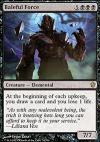|

MV anecdotes
| 940 anecdotes trouvées |   |
La carte Magus of the Will est une référence à Yawgmoth's Will de par son nom, son coût de mana, son effet et son illustration.
La carte Magus of the Wheel est une référence à Wheel of Fortune de par son nom, son coût de mana, son effet et son illustration.
Les cinq cartes Cotton Djinn, Hydro Djinn, Slow Djinn, Rummy Djinn et Slim Djinn, de l'édition Unglued 2 : The Obligatory Sequel (jamais publiée) et illustrées par Edward P. Beard, Jr., forment un cycle appelé "Punny Djinns" et qui ont servi de modèle pour concevoir les Djinns de l'édition Invasion.
• Cotton Djinn a inspiré Ruham Djinn et est un jeu de mots avec "Cotton Gin".
• Hydro Djinn a inspiré Zanam Djinn et est un jeu de mots avec "Hydrogen".
• Slow Djinn a inspiré Goham Djinn et est un jeu de mots avec "Sloe Gin".
• Rummy Djinn a inspiré Halam Djinn et est un jeu de mots avec "Gin Rummy".
• Slim Djinn a inspiré Sulam Djinn et est un jeu de mots avec "Slim Jim".
Source (#broken)
• Cotton Djinn a inspiré Ruham Djinn et est un jeu de mots avec "Cotton Gin".
• Hydro Djinn a inspiré Zanam Djinn et est un jeu de mots avec "Hydrogen".
• Slow Djinn a inspiré Goham Djinn et est un jeu de mots avec "Sloe Gin".
• Rummy Djinn a inspiré Halam Djinn et est un jeu de mots avec "Gin Rummy".
• Slim Djinn a inspiré Sulam Djinn et est un jeu de mots avec "Slim Jim".
Source (#broken)
Les cartes Infernal Spawn of Evil, Infernal Spawn of Infernal Spawn of Evil et Infernius Spawnington III, Esq. forment un cycle. Les illustrations représentent une souris, son fils, puis son petit-fils.
La valeur de mana, les force et endurance ainsi que le nombre de capacités mots-clés de la créature augmentent de un à chaque nouvelle carte.
Source (#37. Like Father, Like Son)
La valeur de mana, les force et endurance ainsi que le nombre de capacités mots-clés de la créature augmentent de un à chaque nouvelle carte.
Source (#37. Like Father, Like Son)
Les cinq cartes Mox Pearl, Mox Sapphire, Mox Jet, Mox Ruby et Mox Emerald, auxquelles s'ajoutent Chrome Mox, Mox Opal et Mox Diamond, illustrées par Volkan Baga, forment un cycle d'illustrations.
La version normale de la carte Mox Jasper, de l'édition Tarkir: Dragonstorm et illustrée par Steven Belledin, fait référence à ce cycle de par la composition de son illustration, à savoir deux mains tenant ladite Mox vues en gros plan. À noter que l'illustration par le même artiste de la précédente Mox éditée, Mox Amber, ne reprend cependant pas cette composition.
La version normale de la carte Mox Jasper, de l'édition Tarkir: Dragonstorm et illustrée par Steven Belledin, fait référence à ce cycle de par la composition de son illustration, à savoir deux mains tenant ladite Mox vues en gros plan. À noter que l'illustration par le même artiste de la précédente Mox éditée, Mox Amber, ne reprend cependant pas cette composition.
La carte Black Lotus, les cinq cartes de moxen Mox Pearl, Mox Sapphire, Mox Jet, Mox Ruby et Mox Emerald, et enfin les cartes Ancestral Recall, Time Walk et Timetwister, de l'édition Limited (Alpha), forment le Power Nine ou P9, les cartes considérées comme étant les plus puissantes de Magic.
La carte Oracle of the Alpha fait directement référence à cet ensemble de cartes.
La carte Oracle of the Alpha fait directement référence à cet ensemble de cartes.
Les quatre cartes Grinding Station, Blasting Station, Salvaging Station et Summoning Station, de l'édition Fifth Dawn, forment un cycle, ainsi qu'un panorama quel que soit l'ordre dans lequel on les place.
Source
Source
Les cinq cartes Oketra the True, Kefnet the Mindful, Bontu the Glorified, Hazoret the Fervent et Rhonas the Indomitable forment un cycle s'inspirant de dieux de la mythologie égyptienne (voir aussi cette anecdote).
• Oketra s'inspire de la déesse Bastet à tête de chat.
• Kefnet s'inspire du dieu Thot à tête d'ibis.
• Bontu s'inspire du dieu Sobek à tête de crocodile.
• Hazoret s'inspire du dieu Anubis à tête de chacal.
• Rhonas s'inspire du dieu Wadjet à tête de cobra.
Les habitants d'Amonkhet vouent un culte à chacune de ces divinités au travers de divers monuments (voir cette série d'anecdotes).
• Oketra s'inspire de la déesse Bastet à tête de chat.
• Kefnet s'inspire du dieu Thot à tête d'ibis.
• Bontu s'inspire du dieu Sobek à tête de crocodile.
• Hazoret s'inspire du dieu Anubis à tête de chacal.
• Rhonas s'inspire du dieu Wadjet à tête de cobra.
Les habitants d'Amonkhet vouent un culte à chacune de ces divinités au travers de divers monuments (voir cette série d'anecdotes).
Les cinq cartes Decree of Justice, Decree of Silence, Decree of Pain, Decree of Annihilation et Decree of Savagery, de l'édition Scourge, forment un cycle appelé "Decree".
L'ombre de Karona, False God se retrouve sur l'illustration de chacune d'entre elles.
L'ombre de Karona, False God se retrouve sur l'illustration de chacune d'entre elles.
Les cinq cartes Purelace, Thoughtlace, Deathlace, Chaoslace et Lifelace, de l'édition Limited (Alpha), forment un cycle appelé "Lace", un des premiers cycles de Magic. Les cartes Prismatic Lace et Moonlace parues ensuite font référence à ce cycle.
Ces cartes ont toutes en commun d'avoir dans leur nom le mot "lace", en français "voile", et de faire changer la couleur d'un permanent ou d'un sort. Cela fait référence au jeu de rôle "The Primal Order" de Wizards of the Coast. Dans ce jeu, les divinités peuvent "voiler" un objet ou un sort avec de l'énergie primitive, l'imprégnant d'une partie de leur propre nature divine, ce qui a inspiré le changement de couleur.
Source
Ces cartes ont toutes en commun d'avoir dans leur nom le mot "lace", en français "voile", et de faire changer la couleur d'un permanent ou d'un sort. Cela fait référence au jeu de rôle "The Primal Order" de Wizards of the Coast. Dans ce jeu, les divinités peuvent "voiler" un objet ou un sort avec de l'énergie primitive, l'imprégnant d'une partie de leur propre nature divine, ce qui a inspiré le changement de couleur.
Source
La carte Cyclopean Titan est une référence à Cyclopean Giant, qui était lui-même un mélange de Cyclopean Mummy et Cyclopean Tomb. Chaque créature a son coût de mana, ses force et endurance multipliés par 2 par rapport à la créature précédente.
De plus la carte située derrière l'illustration de Cyclopean Titan est Cyclopean Giant.
De plus la carte située derrière l'illustration de Cyclopean Titan est Cyclopean Giant.
Les trois cartes Ulamog, the Ceaseless Hunger, Kozilek, the Great Distortion et Emrakul, the Promised End forment le cycle des titans Eldrazis, chacun sorti dans une édition différente.
Les cartes Trinket Mage, Tribute Mage, Trophy Mage, Transit Mage et Treasure Mage forment un méga-méga-cycle d'humains et sorciers appelé "T- Mage", chacun appartenant à une édition différente. Ces cartes coûtent trois manas dont un coloré et permettent de chercher dans la bibliothèque une carte d'artefact avec une valeur de mana dans une plage spécifique.
Source 1 (Micromancer (Dominaria United) - "Trinket Mage was so popular that it spawned two different design paths. The first of these are what I'll call the "T Mages," which tutor for artifacts of a specific mana value range. Trinket Mage gets mana value 1 or less, Tribute Mage gets 2, Trophy Mage gets 3, and Treasure Mage gets 6 or more—yes, that means we haven't finished this cycle yet. [...]")
Source 1 (Micromancer (Dominaria United) - "Trinket Mage was so popular that it spawned two different design paths. The first of these are what I'll call the "T Mages," which tutor for artifacts of a specific mana value range. Trinket Mage gets mana value 1 or less, Tribute Mage gets 2, Trophy Mage gets 3, and Treasure Mage gets 6 or more—yes, that means we haven't finished this cycle yet. [...]")
Source 2 a écrit :
Tribute Mage
This is another card that's trying to help complete a cycle.
It started back in Fifth Dawn with the card Trinket Mage . Fifth Dawn had a "cog" theme focusing on artifacts that cost zero or one. Trinket Mage was designed as a creature that tutored (got a card from your library into your hand) for cogs.
In Mirrodin Besieged, we made a mirror of Trinket Mage with Treasure Mage , a creature that tutored only for expensive artifacts (ones costing six or more).
Aether Revolt started filling in the middle with Trophy Mage which tutored for artifacts costing exactly three mana.
Modern Horizons fills in the two slot, leaving two cards remaining: one that gets converted mana cost 4 and one that gets 5. Let's hope we don't run out of t words.
This is another card that's trying to help complete a cycle.
It started back in Fifth Dawn with the card Trinket Mage . Fifth Dawn had a "cog" theme focusing on artifacts that cost zero or one. Trinket Mage was designed as a creature that tutored (got a card from your library into your hand) for cogs.
In Mirrodin Besieged, we made a mirror of Trinket Mage with Treasure Mage , a creature that tutored only for expensive artifacts (ones costing six or more).
Aether Revolt started filling in the middle with Trophy Mage which tutored for artifacts costing exactly three mana.
Modern Horizons fills in the two slot, leaving two cards remaining: one that gets converted mana cost 4 and one that gets 5. Let's hope we don't run out of t words.
Source 3 a écrit :
Treasure Mage
This story starts back in the design of Fifth Dawn. One of the themes we'd put into the set was something we called cogs. Cogs were artifacts that had a converted mana cost of 1 or less and had small effects. We then made a number of cards in the set which interacted with the cogs to help you build a deck around them. One such card was designed by Aaron Forsythe:
Aaron enjoys tutoring and "enters the battlefield" effects on creatures, so he combined them to make a cog-friendly Wizard. Trinket Mage got printed and has seen play in numerous formats. (Having a lot of powerful artifacts with a converted mana cost of 1 or less in older formats didn't hurt.)
Flash forward a number of years to Mirrodin Besieged. We're back on Mirrodin, so we decided to make a mirror of Trinket Mage called Treasure Mage . Instead of searching for a small artifact (one with a converted mana cost of 1 or less), it looks for a large artifact (one that has a converted mana cost of 6 or more). It was also a 2/2 for 2U, and we called it Treasure Mage to have a similar feel.
While technically the story is done on Treasure Mage 's design, there's still a little more story to tell. The Aether Revolt design team made Trophy Mage , which tutors for an artifact with a converted mana cost of exactly 3. It's also a 2/2 for 2U with a T word in its name. Modern Horizons then made Tribute Mage , which tutors for an artifact with a converted mana cost of exactly 2.
All of this leaves artifacts of converted mana costs 4 or 5 unaccounted for, but I have faith that one day, provided we don't run out of T words, we'll see this—I'm not sure what to call it as "cycle" seems a little off—completed.
This story starts back in the design of Fifth Dawn. One of the themes we'd put into the set was something we called cogs. Cogs were artifacts that had a converted mana cost of 1 or less and had small effects. We then made a number of cards in the set which interacted with the cogs to help you build a deck around them. One such card was designed by Aaron Forsythe:
Aaron enjoys tutoring and "enters the battlefield" effects on creatures, so he combined them to make a cog-friendly Wizard. Trinket Mage got printed and has seen play in numerous formats. (Having a lot of powerful artifacts with a converted mana cost of 1 or less in older formats didn't hurt.)
Flash forward a number of years to Mirrodin Besieged. We're back on Mirrodin, so we decided to make a mirror of Trinket Mage called Treasure Mage . Instead of searching for a small artifact (one with a converted mana cost of 1 or less), it looks for a large artifact (one that has a converted mana cost of 6 or more). It was also a 2/2 for 2U, and we called it Treasure Mage to have a similar feel.
While technically the story is done on Treasure Mage 's design, there's still a little more story to tell. The Aether Revolt design team made Trophy Mage , which tutors for an artifact with a converted mana cost of exactly 3. It's also a 2/2 for 2U with a T word in its name. Modern Horizons then made Tribute Mage , which tutors for an artifact with a converted mana cost of exactly 2.
All of this leaves artifacts of converted mana costs 4 or 5 unaccounted for, but I have faith that one day, provided we don't run out of T words, we'll see this—I'm not sure what to call it as "cycle" seems a little off—completed.
Les cartes Hall of Heliod's Generosity, Academy Ruins et Volrath's Stronghold forment un méga-méga-cycle de terrains légendaires produisant un mana incolore et qui, pour deux manas dont un coloré, permettent de remettre un permanent d'un type défini sur le dessus de votre bibliothèque depuis votre cimetière.
Les cartes Northern Paladin, Southern Paladin, Eastern Paladin et Western Paladin forment un cycle de chevaliers pour quatre manas dont deux colorés, dont les cartes appartiennent à trois éditions différentes. Elles furent ensuite rééditées toutes les quatre dans la 7th Edition.
Les cinq cartes Enlightened Tutor, Mystical Tutor, Vampiric Tutor, Worldly Tutor et Goblin Tutor forment un cycle appelé "Tutor" d'éphémères pour un coût de un mana coloré.
Dans le bloc Mirage/Visions puis la Sixième Édition, seules quatre couleurs ont eu le droit à un tuteur pouvant aller chercher une carte dans la bibliothèque. Cette injustice fut réparée avec l'édition de Goblin Tutor en Unglued.
Source (#52)
Dans le bloc Mirage/Visions puis la Sixième Édition, seules quatre couleurs ont eu le droit à un tuteur pouvant aller chercher une carte dans la bibliothèque. Cette injustice fut réparée avec l'édition de Goblin Tutor en Unglued.
Source (#52)
Les cinq cartes Oath of Gideon, Oath of Jace, Oath of Liliana, Oath of Chandra et Oath of Nissa, complétées plus tard par Oath of Ajani, Oath of Teferi et Oath of Kaya, forment un méga-méga-cycle appelé "Oath" d'enchantements légendaires représentant les serments de chaque planeswalker ayant fait ou faisant partie des Sentinelles. De plus leurs textes d'ambiance se font écho.
Toutes ces cartes sont illustrées par Wesley Burt.
Toutes ces cartes sont illustrées par Wesley Burt.
Les cinq cartes Kor Haven, Teferi's Isle, Volrath's Stronghold, Keldon Necropolis et Yavimaya Hollow forment un méga-méga-cycle de terrains légendaires associés chacun à une couleur de mana. Ces terrains édités chacun dans des éditions différentes représentent des lieux notables liés à la Storyline de l'Aquilon.
Source 1 (Archdruid's Charm - "Skip ahead to Stronghold design [...] The story took place in Volrath's Stronghold [...], and I really wanted to make a legendary land for it. I'd remembered that in Mirage, we made Teferi's Isle as a single legendary land that created blue mana. Inspired by my success with the Atog s but thinking bigger, I came up with an idea that I called the "mega-mega cycle." We would print a card from a cycle once each block for five years.") - Source 2 ("What if Teferi's Isle was the first card of a "mega-mega-cycle?" In each block, R&D would include a legendary land in the cycle for the next five years. (It was called a "mega-mega-cycle" as opposed to a "mega-cycle" since the cards would appear once per block rather than once per set.)") - Source 3 (RL01 Yavimaya Forest - "In Mirage, we made a legendary land called Teferi's Isle , which was the only legendary land in the set. We decided to make it part of a five-year mega-mega cycle, meaning it would span multiple blocks. The lands showed up in the first set of the first year, the second set of the second year, the third set of the third year, the second set of the fourth year, and the first set of the fifth year.")
Source 1 (Archdruid's Charm - "Skip ahead to Stronghold design [...] The story took place in Volrath's Stronghold [...], and I really wanted to make a legendary land for it. I'd remembered that in Mirage, we made Teferi's Isle as a single legendary land that created blue mana. Inspired by my success with the Atog s but thinking bigger, I came up with an idea that I called the "mega-mega cycle." We would print a card from a cycle once each block for five years.") - Source 2 ("What if Teferi's Isle was the first card of a "mega-mega-cycle?" In each block, R&D would include a legendary land in the cycle for the next five years. (It was called a "mega-mega-cycle" as opposed to a "mega-cycle" since the cards would appear once per block rather than once per set.)") - Source 3 (RL01 Yavimaya Forest - "In Mirage, we made a legendary land called Teferi's Isle , which was the only legendary land in the set. We decided to make it part of a five-year mega-mega cycle, meaning it would span multiple blocks. The lands showed up in the first set of the first year, the second set of the second year, the third set of the third year, the second set of the fourth year, and the first set of the fifth year.")
Les cinq cartes Celestial Force, Tidal Force, Baleful Force, Magmatic Force et Verdant Force forment un méga-méga-cycle appelé "Force", d'élémentaux 7/7 avec un coût de huit manas dont trois colorés et une capacité se déclenchant à chaque entretien. Ce cycle est remarquable car il a débuté avec l'édition Tempest (Verdant Force) pour se terminer 16 ans plus tard.
Les cinq cartes Healing Salve, Ancestral Recall, Dark Ritual, Lightning Bolt et Giant Growth forment le premier cycle de cartes de Magic et un des plus remarquables.
• Ancestral Recall est une des cartes les plus fortes de Magic, restreinte en Vintage et bannie de tous les autres formats officiels.
• Lightning Bolt est l'une des cartes, si ce n'est la carte, la plus jouée des formats Modern, Pauper et Peasant.
• Dark Ritual est une carte qui s'imposa à plusieurs reprises en Standard et en Extended.
• Giant Growth est l'une des cartes qui a connu le plus de rééditions dans l'histoire de Magic et donc une carte classique de formats limités.
• Healing Salve quant à elle n'a de notable que le fait qu'elle fasse partie de ce cycle.
Source ("Richard made a common cycle of cards he called "the boons." Each one was an instant that cost a single colored mana that did three of some effect. [...] The power level of the spells were kind of all over the board (with the Ancestral Recall eventually moving to rare), with white having the weakest effect. [...]")
• Ancestral Recall est une des cartes les plus fortes de Magic, restreinte en Vintage et bannie de tous les autres formats officiels.
• Lightning Bolt est l'une des cartes, si ce n'est la carte, la plus jouée des formats Modern, Pauper et Peasant.
• Dark Ritual est une carte qui s'imposa à plusieurs reprises en Standard et en Extended.
• Giant Growth est l'une des cartes qui a connu le plus de rééditions dans l'histoire de Magic et donc une carte classique de formats limités.
• Healing Salve quant à elle n'a de notable que le fait qu'elle fasse partie de ce cycle.
Source ("Richard made a common cycle of cards he called "the boons." Each one was an instant that cost a single colored mana that did three of some effect. [...] The power level of the spells were kind of all over the board (with the Ancestral Recall eventually moving to rare), with white having the weakest effect. [...]")
Les quatre cartes Tower of Fortunes, Tower of Champions, Tower of Murmurs et Tower of Eons forment un cycle appelé "Tower" dans l'édition Mirrodin, qui sera complété avec Tower of Calamities dans l'édition Scars of Mirrodin.
Chaque tour est un artefact avec une valeur de quatre manas, une capacité activée coûtant huit manas et dont les capacités sont chacune associées à une des cinq couleurs de mana et comportent des nombres en progression arithmétique : 4 ; 6 ; 8 ; 10 et 12.
Chaque tour est un artefact avec une valeur de quatre manas, une capacité activée coûtant huit manas et dont les capacités sont chacune associées à une des cinq couleurs de mana et comportent des nombres en progression arithmétique : 4 ; 6 ; 8 ; 10 et 12.
Les cinq cartes Voice of Truth, Voice of Reason, Voice of Grace, Voice of Law et Voice of Duty forment un cycle appelé "Voice" d'anges 2/2 avec la protection contre une des cinq couleurs, parus dans trois éditions différentes. De plus les textes d'ambiance de ces cartes font tous référence au même verset "Canto 167" d'un poème fictif : "Song of All" (voir cette anecdote).
La carte Voice of All, de l'édition Planeshift, qui est un ange 2/2 avec la protection contre la couleur de notre choix, est une référence à ce cycle.
La carte Voice of All, de l'édition Planeshift, qui est un ange 2/2 avec la protection contre la couleur de notre choix, est une référence à ce cycle.
| 940 anecdotes trouvées |   |






 Tarkir: Dragonstorm
Tarkir: Dragonstorm Aetherdrift
Aetherdrift Foundations
Foundations Duskmourn
Duskmourn Bloomburrow
Bloomburrow Modern Horizons III
Modern Horizons III Outlaws of Thunder Junction
Outlaws of Thunder Junction





















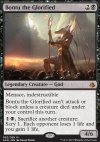
















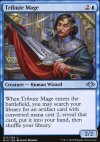






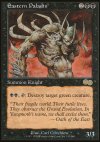
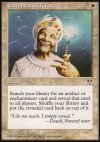




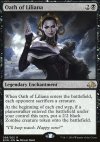


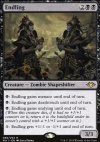
 : This creature gets +1/-1 or -1/+1 until end of turn".
: This creature gets +1/-1 or -1/+1 until end of turn".



